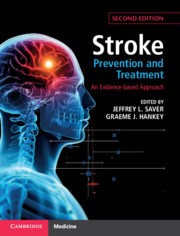Book contents
- Stroke Prevention and Treatment
- Stroke Prevention and Treatment
- Copyright page
- Dedication
- Contents
- Contributors
- Preface
- Part I Foundations
- Part II Systems of Care
- Part III Acute Treatment of Ischaemic Stroke and Transient Ischaemic Attack
- Part IV Acute Treatment of Haemorrhagic Stroke
- Part V Prevention
- Chapter 15 Prevention of Stroke by Lowering Blood Pressure
- Chapter 16 Prevention of Stroke by Lowering Blood Cholesterol Concentrations
- Chapter 17 Prevention of Stroke by Modification of Additional Vascular and Lifestyle Risk Factors
- Chapter 18 Drugs, Devices, and Procedural Therapies to Prevent Recurrent Cardiogenic Embolic Stroke
- Chapter 19 Long-term Antithrombotic Therapy for Large and Small Artery Occlusive Disease
- Chapter 20 Carotid and Vertebral Artery Revascularization
- Chapter 21 Cervical Artery Dissection and Cerebral Vasculitis
- Chapter 22 Prevention of Intracerebral and Subarachnoid Haemorrhage
- Part VI Stroke Rehabilitation and Recovery
- Index
- References
Chapter 21 - Cervical Artery Dissection and Cerebral Vasculitis
from Part V - Prevention
Published online by Cambridge University Press: 15 December 2020
- Stroke Prevention and Treatment
- Stroke Prevention and Treatment
- Copyright page
- Dedication
- Contents
- Contributors
- Preface
- Part I Foundations
- Part II Systems of Care
- Part III Acute Treatment of Ischaemic Stroke and Transient Ischaemic Attack
- Part IV Acute Treatment of Haemorrhagic Stroke
- Part V Prevention
- Chapter 15 Prevention of Stroke by Lowering Blood Pressure
- Chapter 16 Prevention of Stroke by Lowering Blood Cholesterol Concentrations
- Chapter 17 Prevention of Stroke by Modification of Additional Vascular and Lifestyle Risk Factors
- Chapter 18 Drugs, Devices, and Procedural Therapies to Prevent Recurrent Cardiogenic Embolic Stroke
- Chapter 19 Long-term Antithrombotic Therapy for Large and Small Artery Occlusive Disease
- Chapter 20 Carotid and Vertebral Artery Revascularization
- Chapter 21 Cervical Artery Dissection and Cerebral Vasculitis
- Chapter 22 Prevention of Intracerebral and Subarachnoid Haemorrhage
- Part VI Stroke Rehabilitation and Recovery
- Index
- References
Summary
Cervical artery dissection (CAD) is characterized by an intramural haematoma due to a subintimal tear and accounts for up to 25% of ischaemic strokes in young and middle-aged adults. Data regarding intravenous thrombolysis and endovascular thrombectomy in CAD are scarce and observational – both are reasonably safe and probably recommended. Based on observational evidence, antithrombotic therapy is used to prevent first or recurrent cerebral ischaaemic events in acute or subacute CAD, and event rates are low with either antiplatelet or anticoagulant therapy. The long-term rate of recurrent cerebral ischaemic events or bleeding complications in CAD patients is small while under antithrombotic treatment. Cerebral vasculitis treatment is based on observational series. When primary angiitis of the central nervous system is confirmed by biopsy, a combination of glucocorticoids and cyclophosphamide should be started. Rituximab may be used in patients who are intolerant of cyclophosphamide. In atypical, non-biopsy-proven cases, treatment should be adapted to the severity of neurological involvement. For giant cell arteritis, initial high-dose prednisolone is recommended, beginning a slow taper after 2–4 weeks and continuing at a low dose for 1–2 years. Treatment of p-ANCA-positive and -negative systemic vasculitis with cerebral involvement includes induction corticosteroid therapy followed by addition of cyclophosphamide or other glucocorticoid-sparing drugs.
Keywords
- Type
- Chapter
- Information
- Stroke Prevention and TreatmentAn Evidence-based Approach, pp. 450 - 462Publisher: Cambridge University PressPrint publication year: 2020



